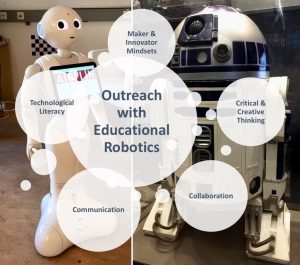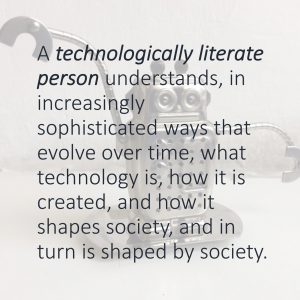Our Scientific Approach
In unserer Arbeit stellen wir Kinder und deren Bedürfnisse immer voran. Wir gestalten die Aktivitäten in Übereinstimmung mit unserem pädagogischen Wissen und richten unsere wissenschaftliche Tätigkeit darauf, den – beabsichtigten oder auch unbeabsichtigten – kurzfristigen Einfluss dieser Aktivitäten zu verstehen. Wir sammeln Daten von vielerlei Quellen – Material, das wir aus unseren Aktivitäten und Interviews gewinnen – und triangulieren die Ergebnisse in einer qualitativen Evaluierung.
Unsere Vision zielt darauf ab, alle jungen Menschen über Robotik und deren Möglichkeiten aufzuklären. Wir verfolgen dabei verschiedene Strategien, indem wir uns auf eine Reihe diverser Kompetenzen beziehen. Hierbei spielt nicht nur Fachwissen über Robotik eine Rolle, sondern auch die Fähigkeit, mit Technologien umzugehen, die 4C Skills des 21. Jahrhunderts (critical and creative thinking, collaboration and communication), Innovationsfähigkeit und Unternehmergeist.

Technologiekompetenz und die „4Cs“
Eines unserer Ziele ist es, jungen Menschen die Bedeutung und Relevanz technologischer Kompetenz näherzubringen.

Unsere Aktivitäten sind außerdem derart gestaltet, dass TeilnehmerInnen ihre Stärken und potenzielle Interessen entdecken können. Für einen erfolgreichen Karriereweg sind die Skills des 21. Jahrhunderts bzw. die sog. „4Cs“ unabdingbar: Sie umfassen kreatives and kritisches Denken, Zusammenarbeit und Kommunikation (creative and critical thinking, collaboration and communication). Unser Programm bietet jungen Menschen den Raum, diese Kompetenzen selbst weiterzuentwickeln – hier und da mit etwas Hilfe von unserer Seite.
Maker, Innovator und Entrepreneur Mindsets
Einige unserer Aktivitäten sollen jungen Menschen helfen, die Freude des Schaffens (wieder) zu entdecken. Besonderes Augenmerk wird darauf gelegt, ihr kreatives Selbstbewusstsein sowie ihre empfundene Selbstwirksamkeit zu stärken. Dabei ist das Gleichgewicht zwischen Struktur und Freiheit entscheidend. Das von Stanfords d school entwickelte Konzept Design Thinking vermittelt nicht nur einen Prozess für Schaffen und Innovationsfähigkeit, sondern auch eine auf Offenheit und Mitgefühl fundierte Einstellung. Je nach Alter ermutigen wir zudem die TeilnehmerInnen, ihre unternehmerische Seite weiterzuentwickeln, beispielsweise durch die Konzipierung von Produktlösungen in der Robotik und die Präsentation eben dieser vor ExpertInnen.
Definition von Technologie
Wir definieren Technologie als menschengemachte und nutzenorientierte Artefakte – im Gegensatz zur Natur, die auch ohne menschliche Handlung existieren und wachsen kann. Unsere Definition von Technologie beinhaltet außerdem das Wissen um Artefakte und wie man sie schafft und nutzt.
Definition von Roboter
Wir definieren einen Roboter als eine autonome, selbstangetriebene Technologie in einer physischen Form, die ihr Umfeld registriert, auf Änderungen reagiert und womöglich selbst Änderungen einleiten kann.
Die physische Form ist grundlegend. Software Algorithmen oder Avatare sind keine Roboter. Hingegen ist eine humanoide oder anthropomorphe Gestalt kein notwendiges Kriterium, um ein Artefakt als Roboter zu klassifizieren. Roboter können jedwede Form annehmen.
Die Fähigkeit zu lernen – und die Strategien im Umgang mit dem jeweiligen Umfeld zu adaptieren – wird als machine learning oder, allgemeiner, künstliche Intelligenz (bzw. artificial intelligence, AI) bezeichnet. Definitionsgemäß muss ein Roboter nicht lernfähig sein. Verfügt ein Roboter über machine learning Algorithmen, so ist er ein Roboter mit künstlicher Intelligenz.
Pädagogischer Hintergrund
Aktivitäten zu Robotik im Bildungsbereich speisen sich aus unterschiedlichen pädagogischen Ansätzen, so z.B. Konstruktionismus, projektbasiertem Lernen, design-basiertem Lernen, problembasiertem Lernen, kollaborativem Lernen, learning by doing oder untersuchungsbasiertem Lernen. Diese Ansätze schließen sich gegenseitig nicht aus und können daher im Sinne einer ganzheitlichen Lernerfahrung kombiniert werden.
Motivation und Emotionen spielen beim Lernen eine zentrale Rolle. Kinder wollen wachsen, sich durchsetzen, lieben und geliebt werden. Daher sollen Lernaktivitäten an das Leben und die Interessen der Kinder angepasst werden (Piaget, 1969) und ihnen die Möglichkeit geben, im Spielen zu lernen (Montessori, 1964). Diese Ideen liegen dem theoretischen Ansatz des Konstruktivismus zugrunde. Das Lernen wird außerdem durch das soziale Netzwerk bereichert; Wissen und Strategien werden in der Begegnung mit anderen Menschen geteilt und weiterentwickelt. Sprache, Werkzeuge und Artefakte sind wichtige Medien, um Ideen zu externalisieren, was seinerseits für die Kommunikation mit anderen unabdingbar ist (Vygotsky, 1978).
Materielle Artefakte sind das Fundament einer bedeutenden Theorie von Lernen und Bildungsstrategien, die von Seymour Papert – aufbauend auf das konstruktivistische Rahmenkonzept von Piaget und anderen – stammt: Konstruktionismus. Die Kernidee lautet, dass Lernende aktiv Wissen aus ihren Erfahrungen in der Welt konstruieren und rekonstruieren, indem sie Artefakte schaffen, die für sie persönlich bedeutungsvoll sind (Kafai und Resnick, 1996). Basierend auf die Prinzipien des Konstruktionismus schlägt Resnick (2014) vier Elemente vor, damit sich Kinder entfalten können: project, passion, peers and play (Projekt, Leidenschaft, Kommilitonen und Spiel). Menschen lernen am besten, wenn sie an Projekten arbeiten, die ihnen viel bedeuten, und dabei neue Ideen ersinnen, Prototypen entwerfen und diese iterativ verfeinern. Ist das Projekt direkt relevant für ihr Leben oder bedeutet es ihnen besonders viel, so arbeiten Menschen intensiver und länger, zeigen mehr Durchhaltevermögen und entwickeln vielleicht sogar eine Leidenschaft für die jeweilige Unternehmung. Wenn Menschen Ideen austauschen und an Projekten zusammenarbeiten, gewinnt das Lernen zusätzlichen Reiz als soziale Aktivität. Das Lernen beinhaltet außerdem eine spielerische Experimentierfreude, eine Offenheit für Neues sowie Risikobereitschaft (Resnick, 2014).
Gleichzeitig erlaubt das Spielen, neben rationalen Bestreben (z.B. nützliche Artefakte zu schaffen) auch Humor und Leichtigkeit nachzugehen, welche ebenso zu neuen Erkenntnissen führen (z.B. durch die Anregung der Fantasie) (Ackerman, 2014). Neue Einsichten oder Ideen können dann in verschiedener Form externalisiert werden, beispielsweise als Gedicht oder Lied (auditiv), Prototyp oder Zeichnung (taktil) oder auch Schema oder Beschreibung (visuell); somit werden sie greifbar und mitteilbar, was wiederum der Herausarbeitung und Transformation von Ideen zuträglich ist (Papert und Harel, 1991). Da das Mitteilen von Ideen und deren Ausarbeitung auf Basis von zwischenmenschlichen Erfahrungen für den konstruktionistischen Lernprozess entscheidend sind, werden Zusammenarbeit und Kommunikation insgesamt als wesentliche konstruktionistische Elemente verstanden (Kafai und Resnick, 1996).
Projektbasiertes Lernen (PBL) geht ebenfalls von konstruktivistischen Lerntheorien aus (Condliffe, 2016) und hat mit Konstruktionismus zahlreiche Gemeinsamkeiten. Dieser Ansatz fördert tiefgehendes Lernen und die Skills des 21. Jahrhunderts (Pellegrino und Hilton, 2012), indem Lernende aktiv Herausforderungen des realen Lebens untersuchen und dadurch zu Wissen und profunder Recherche gelangen. Diese Aktivitäten können auch komplexe soziale Problemlösungsprozesse von Experten widerspiegeln, und damit Lernenden Fähigkeiten wie Problemlösung und kritisches Denken näherbringen. Zudem sollen Kompetenzen in Teamfähigkeit Lernenden ermöglichen, kollidierende Ideen gegenüberzustellen und in Einklang zu bringen (Condliffe, 2016).
Condliffe (2016) fasst die Gestaltungsprinzipien von PBL Aktivitäten in ihrer Literaturanalyse folgendermaßen zusammen:
1. Prinzipien rundum Lehrplangestaltung (was wird gelehrt?)
a. Fragen anregen, um das Lernen zu motivieren
b. Wesentliche Lernziele anpeilen
c. Projekte nutzen, um Lernen zu fördern
d. Genügend Zeit bereitstellen
2. Instruktive Ansätze (wie entwickeln Lernende neue Kompetenzen und Wissen?)
a. Wissenskonstruktion fördern
b. Zu Engagement ermutigen
c. Lernen systematisch leiten und lenken
d. Freie Wahlmöglichkeiten bereitstellen
e. Kollaboratives Lernen unterstützen
3. Prinzipien rundum Beurteilung (wie zeigen Studierende ihr Lernen?)
a. Erstellung eines Produkts, das die Frage beantwortet
b. Möglichkeiten bereitstellen für Reflexion und Feedback
c. Vorstellung von Produkten vor einem echten Publikum
Design-basiertes Lernen ist eine Sonderform des PBL. Ziel ist, jungen Menschen eine ganzheitliche Vorstellung von Produktdesign sowie auch die Praktiken des Design Thinking zu vermitteln (Grammenos, 2015).
Literatur
Ackermann, E. 2014. Amusement, Delight, Whimsy, and Wit, the Place of Humor in Human Creativity. In Constructionism 2014 International Conference, Vienna, Austria.
Condliffe, B., Visher, M. G., Bangser, M. R., Drohojowska, S., and Saco, L. 2016. Project-Based Learning: A Literature Review. MDRC.
Grammenos, D. 2015. Future designers: a rollercoaster for the mind. In Interactions, 23(1), 58-63.
Kafai, Y. B. and Resnick, M. (Eds.). 1996. Constructionism in practice: Designing, thinking, and learning in a digital world. Hillsdale, NJ: Erlbaum.
Montessori, 1964. The Montessori method. (George, A.E., trans.). New York: Schocken.
Papert, S. and Harel, I. 1991. The Constructionism. Ablex Publishing Corporation.
Pellegrino, J. W. and Hilton, M. L. (Eds.). (2012). Education for life and work: Developing transferable knowledge and skills in the 21st century. Washington, DC: National Academies Press.
Piaget, J. & Inhelder, B. 1969. The Psychology of the child.
Resnick, M. 2014. Give P’s a chance: Projects, Peers, Passion, Play. In Proceedings of Constructionism and Creativity Conference, Vienna, Austria.
Vygotsky, L.S. 1978. Mind in Society: The Development of Higher Psychological Processes. Harvard University Press.